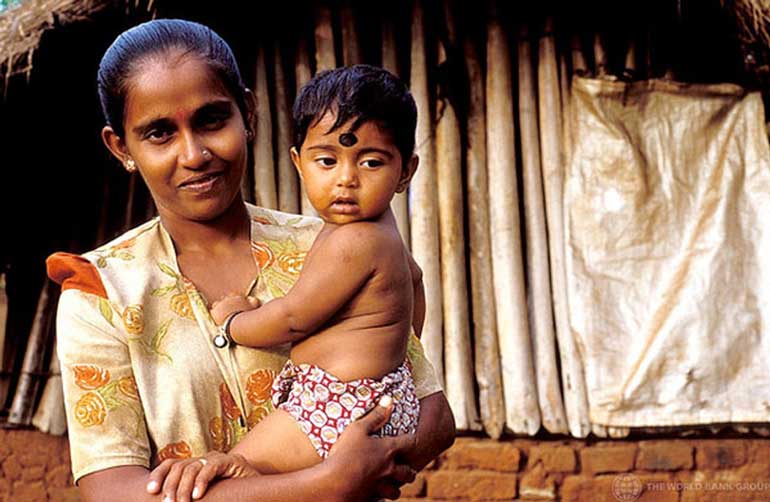Friday Dec 05, 2025
Friday Dec 05, 2025
Saturday, 19 September 2015 00:09 - - {{hitsCtrl.values.hits}}

Recent evidence suggests that Sri Lanka’s 26-year internal armed conflict is an important factor contributing to the upward trend in WHHs, particularly in the Northern and Eastern Provinces of the country
By Vagisha Gunasekara and Ruvani Fonseka for the Centre for Poverty Analysis (CEPA)
Increasing numbers
of women-headed households
The marked increase in women-headed households (WHHs) is arguably one of the most significant features of post-war Sri Lanka as highlighted by a study on WHHs released last month by FOKUS WOMEN. In Sri Lanka, the proportion of WHHs has been consistently increasing since the 1970s, reaching nearly one-quarter of all households by 2009/10. According to the most recent Household Income and Expenditure Survey (2012/13), out of 5.2 million households in Sri Lanka, 1.2 million households or 23% of the households are women-headed.
Recent evidence suggests that Sri Lanka’s 26-year internal armed conflict is an important factor contributing to the upward trend in WHHs, particularly in the Northern and Eastern Provinces of the country. Currently, there are 58,121 WHHs in the Northern Province alone and studies show that members of these households face profound, multi-faceted vulnerabilities, many of which were produced by the war but deepened in the post-war period. Undoubtedly there are others, in other parts of the island that have lost husbands and loved ones in the war (i.e. families of soldiers), as well as those with spouses that have migrated out of the country seeking economic opportunities.
Targeting WHHs:
A contested subject
The high number of WHHs has come to occupy a prominent place in development discourse and practice in Sri Lanka’s post-war context. International organisations, local NGOs and the Government of Sri Lanka are implementing a multitude of development programs, ranging from housing to food aid to livelihood assistance, targeting WHHs as a vulnerable category.
The focus on WHHs as vulnerable is largely due to decades of global research evidence emphasising women’s household headship as an indicator of poverty. Women account for a disproportionate number of the poor worldwide, and male-headed households usually have multiple advantages due to the relative power their heads have in male-dominated societies.
Many argue that women who head households deserve special attention because they are triply disadvantaged: they are poor, they are discriminated against based on their gender, and they lack social support systems as heads of households. When the experience and the effects of war are factored in, women-headed households in war-stricken areas are undoubtedly among the most vulnerable. While a number of development initiatives in war-affected areas either target WHHs or include them among the most vulnerable in selecting beneficiaries, we have little evidence about the extent to which such interventions have improved the lives of WHHs.
Despite the plethora of now fashionable run-of-the-mill projects spread across the north and the east of Sri Lanka, development programs targeting WHHs remains a contested subject. These contestations are predominantly rooted in the narrow ways in which WHHs are defined and understood. As definitional issues greatly shape which questions are asked and which data is collected, there are doubts about whether the current interventions will yield fruitful outcomes for WHHs.
There are practical difficulties in identifying the headship of a household, as standard definitions of a household also remain problematic. Feminist writers have described “the household” as a geographically and historically dynamic social institution in which gender is embedded and negotiated. Exploring intra-household gender dynamics become important as the household is not simply a basic unit of society where individuals both cooperate and compete for resources, but the primary place where individuals confront and reproduce norms, values, power and privilege. Gender norms expressed within the household are reinforced and reflected in larger institutions of society.
Researchers, activists and practitioners have stressed the need to consider the diversity of households, families and kinship groups in gender-aware development interventions. Unfortunately, there seems to be less enthusiasm to consider gender interventions at the domestic level. Development practitioners are slow to embrace more flexible definitions of the household. In particular, they struggle to accept that sometimes WHHs may even represent beneficial environments for women and their dependents, challenging the gender norms and limitations easily reinforced within a traditional heterosexual, two parent-headed household.
Towards a nuanced understanding of households and vulnerability
Household composition and headship vary across time and place. However, two parent-headed heterosexual households are often implicitly placed at the pinnacle of the development process. This placement often leads to misguided policy interventions that result in exclusion and eventual failures in development.
Assuming that households with a heterosexual couples and their children are the “natural” order of things is contradicted by official data that nearly one-fourth of Sri Lankans live in WHHs. Connecting the increasing number of WHHs to crises in family, community or social structures assumes a negative relationship. But WHHs are a heterogeneous group with differing realities and such assumptions are not applicable across different settings or within different types of households.
Assumptions about the “ideal” household are intrinsic to the design and desired outcomes of development processes. Hence we intend to start a series of articles considering “the household” as understood by states and non-state actors in an attempt to encourage nuanced and innovative thinking on the topic. While states, international organisations and local NGOs hesitate to acknowledge multiple formations of households, some women struggle to maintain “ideal” households while others develop their power through “alternative” forms of households.